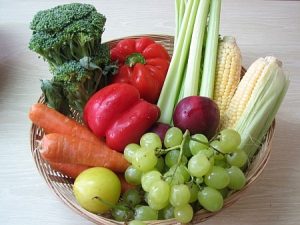Go Meatless for Your Family’s Health and the Planet’s
Todd L Sack MD FACP
Why not “go meatless” for at least one day each week? Call it “Meatless Monday!” Good nutrition means eating foods containing protein along with a balance of carbohydrates, fats, vitamins and minerals. This is true for children and adults. But some proteins are healthier than others, healthier for our bodies and for the natural environment.
To explain this, I am sharing ideas from an excellent website, www.PhARM.org, edited by Dr Michael Martin of the University of California School Medicine in San Francisco, California, USA. Dr. Martin, who founded the non-profit organization “Physicians Against Red Meat”, urges health professionals and patients to advocate for meatless hospitals and homes.
If asked to give ratings to food, your doctor and Mother Nature would likely given foods the same grades. The foods that are best for our health are usually the best for the environment. Topping list are grains, beans (including soy products), lentils, potatoes, rice, nuts, vegetables, and fruits. Vegetables and fruits are relatively low in protein but terrific for their health and environmental benefits. The next best food category includes fish and shellfish; high in protein and offering among the healthiest types of fats. In the third category are dairy products, such as milk, yogurt, cheese, eggs, and poultry. The worst are the “red meats”, those derived from four-legged animals such as cows, pigs, sheep and goats.
All proteins are chains of smaller molecules called “amino acids”. We need a mixture of different amino acids in our diet in order for our bodies to have all the ingredients necessary to synthesize our own proteins. We want to get our dietary proteins from a variety of foods in order to have all the amino acid types that our cells require.
Interestingly, we do not need any “red meat” to get the right amounts of the necessary amino acids. Plus, red meats are high in the worst types of fats that lead to heart disease, diabetes, dementia, and even cancer. In 2017, the World Health Organization went even further to list processed meats, such as salamis, bacon, prosciutto, and cured ham, as carcinogenic, meaning that they may cause cancer. They may taste great but you really want to avoid these! Switching to wiser choices can make a big difference. PhARM.org tells us that, “the Harvard School of Public Health studied the diets of 150,000 health professional, and concluded that replacing red meat with fish, legumes, nuts, and whole grains decreases all-cause mortality by 8-9%.” (Reference 1).
Dietary protein can be particularly dangerous for people with advanced liver problems, kidney diseases and certain rare metabolic disorders. These patients usually are instructed to restrict the amount of protein in the diet and often to avoid animal protein. A vegetarian diet can greatly improve patient quality of life, and even survival.
“TWENTY servings of vegetables creates fewer climate-warming greenhouse gas emissions than ONE serving of beef.”
Let’s look at the impact of foods on the global climate. Every step in food production produces climate warming greenhouse gases: plowing fields, using fertilizers, raising animals, transporting foods, packaging, cooking and disposal. When fuels such as gasoline and diesel are burned, carbon dioxide is released to the air. The worst greenhouse gases are methane and nitrous oxide, with the largest sources of those coming from 4-footed livestock animals. Methane –which is also the chief component of natural gas that is burned to make electricity– is 86-fold more heat-trapping than carbon dioxide over twenty years. The impact is enormous: livestock production around the world is responsible for 18% of ALL man-made global greenhouse gases!
The bottom line is that 20 servings of vegetables creates fewer greenhouse gas emissions than 1 serving of beef.
Here are suggestions from Dr. Martin:
-
Eat less meat. Choose fish, shrimp, and poultry.
-
Never consume red meat or processed meats (salami, bacon, cured ham).
-
Try “Meatless Mondays” for your family and yourself.
-
Try the great, tasty protein alternatives: beans, lentils, peas, soy products, nuts, and seeds.
- Experiment with fun vegetarian and vegan recipes.
-
Try the alternatives to meat, now made with soy, kale and grains, that you’ll find in grocery stores and restaurants.
“Going Meatless” is one of My Green Doctor’s “Tip of the Month” ideas. Every healthcare office can adopt one of our tips each month to share in conversation, in a brochure, as a waiting room poster, or in the patient’s printed check-out instructions. These tips are great for patient health, can save your patients lots of money, make for a cleaner environment, and support a healthier climate.
You can see the full list at https://mygreendoctor.org/tip-of-the-month/ .
Todd L Sack, MD FACP
Editor, My Green Doctor
Fall 2019
My Green Doctor is a joint project of 11 health professional organizations, teaching environmental sustainability and climate change awareness in healthcare offices worldwide.
Send us your feedback: [email protected].
Reference 1: Pan, A., et al., Red meat consumption and mortality: results from 2 prospective cohort studies. Arch Intern Med, 2012. 172(7): p. 555-63.





